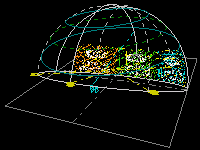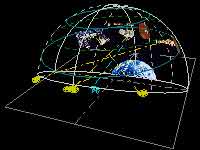| In the production studio: Computer with CD-ROM drive Image processing software Output device |
| In the theater 1. At least three dissolve-pair slide projectors in L-C-R array |
| 2. Dissolving horizon panorama and/or all-sky projector system |
| 3. A capable planetarium projector with planets and annual motion |
| Recommended: Zoom-slew Meteors SFX |
| NOT used: Video |
MarsQuest Equipment Requirements
With more than 300 images to show, MarsQuest is visually complex, and requires a well-equipped planetarium theater to present. It's not for the "faint of dome". We've provided this page to help you determine if your planetarium has the necessary equipment to present MarsQuest.
The show soundtrack is recorded on CD, so you'll need a CD player to play the disc, even if it's just to copy the audio to another medium, such as multi-track tape or hard drive.
The show's still images are recorded on data CD, so you'll need the resources (computer, image processing software, output devices) to transform the digital images into whatever form your theater uses to project. For classic (slide-projector-based) planetaria, that will mean making 35mm slides.
1. At least three dissolve-pair slide projectors in Left-Center-Right array
This is a screen format familiar to long-time Loch Ness Productions customers.
Many of the scenes in our shows are illustrated with three images, which are introduced in sequential order: Left, then Center, then Right. After all three are up, they often "wipe" off in the same order.
There are eight lap-dissolve sequences, several of which appear simultaneously in adjoining screens. Your presentation will benefit if your dissolve screens are more than two projectors deep, so that you can cycle through the animations repeatedly.
We say "at least three" dissolve screens, but the more, the merrier. There are several points in the show where you may wish to make a whole-dome montage of images, such as the opening "Gods" scene, and the Viking section.
2. Dissolving horizon panorama and/or all-sky projector system
There are 21 multi-panel images in the show — which, using 20th-century terms, can be translated as horizon chords and panoramas. In the digital age, what may be a 3-panel pan in one theater may be a 2- or 4-panel pan in another, or a pan can be remapped to an all-sky. Nonetheless, you'll need that calibrated set of projectors which project on the horizon, commonly known as a panorama system. Actually, you'll need two sets, because the ending of the show requires a dissolve from a day to a night Mars panorama.
As you know, individual slide frames are in a 3:2 ratio. Most of the multi-panel images in the show are in a 9:2 format ratio — what might otherwise be called "3-panel partial pans". These are intended to span approximately 90 degrees on the horizon.
All this is in addition to the dissolvers, which project up in the sky, of course. There are times you'll use both together, such as when a chord is on the horizon, and spacecraft on orbit above it.
Actually, using dedicated projector with an anamorphic lens to stretch the chord images works even better.
3. A capable planetarium projector with planets and annual motion
There are two sections in the show that require planetarium annual motion. The first mentions "stars" wandering against the celestial backdrop, so we need to see those wandering planets; the second annual motion section features Mars only.
Beyond that, MarsQuest uses the planetarium star projector primarily for its starfield, when depicting space scenes. When we're not depicting space scenes — quite often, actually — we recommend fading stars out. The starfield shouldn't be generic wallpaper throughout the show.
While non-moving slides can illustrate the scenes, the show will benefit from having spacecraft flying by Mars, Hubble drifting slowly in Earth orbit, the Viking lander landing, etc. At the beginning of "Mars In The Future," you have an armada of spacecraft to fly to Mars. Capable zoom-slews could also perform pointer functions.
For those without special-effect projectors for meteors, we provide two slides for the purpose: a cluster of ten various sized streaks from a central radiant point, and a bolide streak. We expect you'll find one or two that will look good on your dome, and mask off the others.
The opening "Gods" section can benefit from a whole-dome "swirling vapors" lumia-type effect, though it's not required.
NOT used: Video
We use no moving video with the show, intentionally. This is a program designed for the pacing of still imagery. The visual style of the show is non-dynamic slides. To have inserted just one or two video clips would have been very jarring and out-of-context with the remainder of the show. In other words, why would there be only one or two scenes that feature full motion animation, when the rest of the show doesn't have any?







